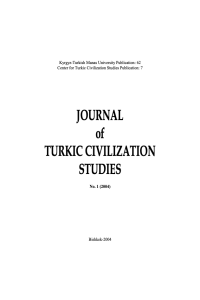Öz
The migration and settlement of Oghuz groups, who were also known as Turkmens in Anatolia, were closely related with the political and demographic developments in the Great Seljuk Empire. But in order to understand these developments better, it would be reasonable to dwell first a little on the conditions under which the Oghuz groups lived before migrating to Anatolia, and look to the reasons behind their inclination towards Anatolia. The Oghuz groups, who constituted an important part of the Göktürk and Uygur states, lived along the banks of the Sır Darya River and on the steppes lying to the north of this river in the first half of the tenth century1. Those were nomadic people, and they made a living out of stock breeding, so they needed summer pastures and winter quarters on which they had to raise their animals and survive through cold winter days comfortably. In addition to them, there were sedentary Oghuz groups. In those days, the sedentary Oghuz groups were called "yatuk"2 which means lazy. This indicates that leading a nomadic life was more favorable then.
Anahtar Kelimeler
Kaynakça
- Kâşgarlı Mahmud, Divanü Lûgat-it Türk (Translation: B. Atalay), III, Ankara 1941, pp. 14-15.
Ayrıntılar
| Birincil Dil | Türkçe |
|---|---|
| Konular | Tarih Sosyolojisi |
| Bölüm | Araştırma Makalesi |
| Yazarlar | |
| Yayımlanma Tarihi | 30 Haziran 2004 |
| Yayımlandığı Sayı | Yıl 2004 Cilt: 1 Sayı: 1 |
Journal of Turkic Civilization Studies © 2022 by TUAUM is licensed under Attribution-NonCommercial 4.0 International
Journal of Turkic Civilization Studies by TUAUM is licensed under Attribution-NonCommercial 4.0 International


